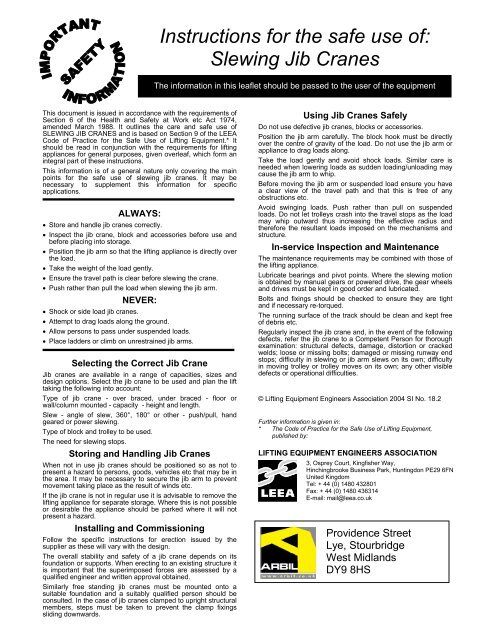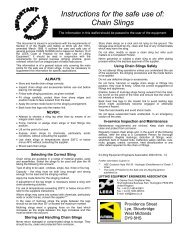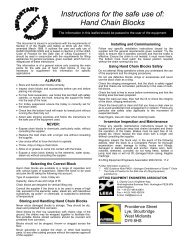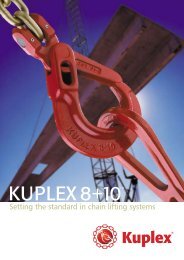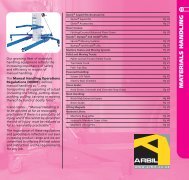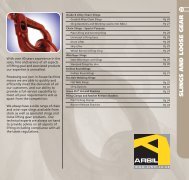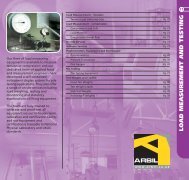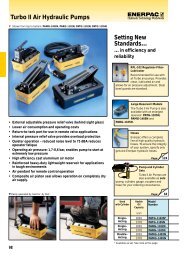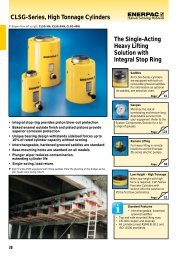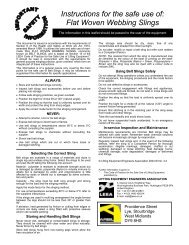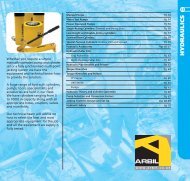Instructions for the safe use of: Slewing Jib Cranes - Arbil Lifting Gear
Instructions for the safe use of: Slewing Jib Cranes - Arbil Lifting Gear
Instructions for the safe use of: Slewing Jib Cranes - Arbil Lifting Gear
You also want an ePaper? Increase the reach of your titles
YUMPU automatically turns print PDFs into web optimized ePapers that Google loves.
<strong>Instructions</strong> <strong>for</strong> <strong>the</strong> <strong>safe</strong> <strong>use</strong> <strong>of</strong>:<strong>Slewing</strong> <strong>Jib</strong> <strong>Cranes</strong>The in<strong>for</strong>mation in this leaflet should be passed to <strong>the</strong> <strong>use</strong>r <strong>of</strong> <strong>the</strong> equipmentThis document is issued in accordance with <strong>the</strong> requirements <strong>of</strong>Section 6 <strong>of</strong> <strong>the</strong> Health and Safety at Work etc Act 1974,amended March 1988. It outlines <strong>the</strong> care and <strong>safe</strong> <strong>use</strong> <strong>of</strong>SLEWING JIB CRANES and is based on Section 9 <strong>of</strong> <strong>the</strong> LEEACode <strong>of</strong> Practice <strong>for</strong> <strong>the</strong> Safe Use <strong>of</strong> <strong>Lifting</strong> Equipment.* Itshould be read in conjunction with <strong>the</strong> requirements <strong>for</strong> liftingappliances <strong>for</strong> general purposes, given overleaf, which <strong>for</strong>m anintegral part <strong>of</strong> <strong>the</strong>se instructions.This in<strong>for</strong>mation is <strong>of</strong> a general nature only covering <strong>the</strong> mainpoints <strong>for</strong> <strong>the</strong> <strong>safe</strong> <strong>use</strong> <strong>of</strong> slewing jib cranes. It may benecessary to supplement this in<strong>for</strong>mation <strong>for</strong> specificapplications.ALWAYS:• Store and handle jib cranes correctly.• Inspect <strong>the</strong> jib crane, block and accessories be<strong>for</strong>e <strong>use</strong> andbe<strong>for</strong>e placing into storage.• Position <strong>the</strong> jib arm so that <strong>the</strong> lifting appliance is directly over<strong>the</strong> load.• Take <strong>the</strong> weight <strong>of</strong> <strong>the</strong> load gently.• Ensure <strong>the</strong> travel path is clear be<strong>for</strong>e slewing <strong>the</strong> crane.• Push ra<strong>the</strong>r than pull <strong>the</strong> load when slewing <strong>the</strong> jib arm.NEVER:• Shock or side load jib cranes.• Attempt to drag loads along <strong>the</strong> ground.• Allow persons to pass under suspended loads.• Place ladders or climb on unrestrained jib arms.Selecting <strong>the</strong> Correct <strong>Jib</strong> Crane<strong>Jib</strong> cranes are available in a range <strong>of</strong> capacities, sizes anddesign options. Select <strong>the</strong> jib crane to be <strong>use</strong>d and plan <strong>the</strong> lifttaking <strong>the</strong> following into account:Type <strong>of</strong> jib crane - over braced, under braced - floor orwall/column mounted - capacity - height and length.Slew - angle <strong>of</strong> slew, 360°, 180° or o<strong>the</strong>r - push/pull, handgeared or power slewing.Type <strong>of</strong> block and trolley to be <strong>use</strong>d.The need <strong>for</strong> slewing stops.Storing and Handling <strong>Jib</strong> <strong>Cranes</strong>When not in <strong>use</strong> jib cranes should be positioned so as not topresent a hazard to persons, goods, vehicles etc that may be in<strong>the</strong> area. It may be necessary to secure <strong>the</strong> jib arm to preventmovement taking place as <strong>the</strong> result <strong>of</strong> winds etc.If <strong>the</strong> jib crane is not in regular <strong>use</strong> it is advisable to remove <strong>the</strong>lifting appliance <strong>for</strong> separate storage. Where this is not possibleor desirable <strong>the</strong> appliance should be parked where it will notpresent a hazard.Installing and CommissioningFollow <strong>the</strong> specific instructions <strong>for</strong> erection issued by <strong>the</strong>supplier as <strong>the</strong>se will vary with <strong>the</strong> design.The overall stability and <strong>safe</strong>ty <strong>of</strong> a jib crane depends on itsfoundation or supports. When erecting to an existing structure itis important that <strong>the</strong> superimposed <strong>for</strong>ces are assessed by aqualified engineer and written approval obtained.Similarly free standing jib cranes must be mounted onto asuitable foundation and a suitably qualified person should beconsulted. In <strong>the</strong> case <strong>of</strong> jib cranes clamped to upright structuralmembers, steps must be taken to prevent <strong>the</strong> clamp fixingssliding downwards.Using <strong>Jib</strong> <strong>Cranes</strong> SafelyDo not <strong>use</strong> defective jib cranes, blocks or accessories.Position <strong>the</strong> jib arm carefully. The block hook must be directlyover <strong>the</strong> centre <strong>of</strong> gravity <strong>of</strong> <strong>the</strong> load. Do not <strong>use</strong> <strong>the</strong> jib arm orappliance to drag loads along.Take <strong>the</strong> load gently and avoid shock loads. Similar care isneeded when lowering loads as sudden loading/unloading mayca<strong>use</strong> <strong>the</strong> jib arm to whip.Be<strong>for</strong>e moving <strong>the</strong> jib arm or suspended load ensure you havea clear view <strong>of</strong> <strong>the</strong> travel path and that this is free <strong>of</strong> anyobstructions etc.Avoid swinging loads. Push ra<strong>the</strong>r than pull on suspendedloads. Do not let trolleys crash into <strong>the</strong> travel stops as <strong>the</strong> loadmay whip outward thus increasing <strong>the</strong> effective radius and<strong>the</strong>re<strong>for</strong>e <strong>the</strong> resultant loads imposed on <strong>the</strong> mechanisms andstructure.In-service Inspection and MaintenanceThe maintenance requirements may be combined with those <strong>of</strong><strong>the</strong> lifting appliance.Lubricate bearings and pivot points. Where <strong>the</strong> slewing motionis obtained by manual gears or powered drive, <strong>the</strong> gear wheelsand drives must be kept in good order and lubricated.Bolts and fixings should be checked to ensure <strong>the</strong>y are tightand if necessary re-torqued.The running surface <strong>of</strong> <strong>the</strong> track should be clean and kept free<strong>of</strong> debris etc.Regularly inspect <strong>the</strong> jib crane and, in <strong>the</strong> event <strong>of</strong> <strong>the</strong> followingdefects, refer <strong>the</strong> jib crane to a Competent Person <strong>for</strong> thoroughexamination: structural defects, damage, distortion or crackedwelds; loose or missing bolts; damaged or missing runway endstops; difficulty in slewing or jib arm slews on its own; difficultyin moving trolley or trolley moves on its own; any o<strong>the</strong>r visibledefects or operational difficulties.© <strong>Lifting</strong> Equipment Engineers Association 2004 SI No. 18.2Fur<strong>the</strong>r in<strong>for</strong>mation is given in:* The Code <strong>of</strong> Practice <strong>for</strong> <strong>the</strong> Safe Use <strong>of</strong> <strong>Lifting</strong> Equipment,published by:LIFTING EQUIPMENT ENGINEERS ASSOCIATION3, Osprey Court, Kingfisher Way,Hinchingbrooke Business Park, Huntingdon PE29 6FNUnited KingdomTel: + 44 (0) 1480 432801Fax: + 44 (0) 1480 436314E-mail: mail@leea.co.ukProvidence StreetLye, StourbridgeWest MidlandsDY9 8HS
LIFTING APPLIANCES FOR GENERALPURPOSES(MANUAL AND POWER OPERATED BLOCKS)The following in<strong>for</strong>mation is based on Section 1 - Appendix 1.6<strong>of</strong> <strong>the</strong> Code <strong>of</strong> Practice <strong>for</strong> <strong>the</strong> Safe Use <strong>of</strong> <strong>Lifting</strong> Equipment*and should be read in conjunction with <strong>the</strong> instructions <strong>for</strong> <strong>safe</strong><strong>use</strong>, given overleaf, <strong>of</strong> which it <strong>for</strong>ms an integral part and withany specific instructions issued by <strong>the</strong> supplier.This in<strong>for</strong>mation is <strong>of</strong> a general nature only covering <strong>the</strong> mainpoints <strong>for</strong> <strong>the</strong> <strong>safe</strong> <strong>use</strong> <strong>of</strong> manual and power operated blocks.ALWAYS:• Ensure suspension points and anchorages are adequate <strong>for</strong><strong>the</strong> full imposed load.• Check <strong>the</strong> load chain/wire rope is hanging freely and is nottwisted or knotted.• Position <strong>the</strong> hook over <strong>the</strong> centre <strong>of</strong> gravity <strong>of</strong> <strong>the</strong> load.• Check <strong>the</strong> operation <strong>of</strong> <strong>the</strong> brake be<strong>for</strong>e making <strong>the</strong> lift.• Ensure <strong>the</strong> slings are secure and load is free to be lifted.• Check <strong>the</strong> travel path is clear.• Ensure <strong>the</strong> landing area is properly prepared.NEVER:• Exceed <strong>the</strong> marked SWL.• Use <strong>the</strong> load chain/wire rope as a sling.• Shock load <strong>the</strong> block or o<strong>the</strong>r equipment.• Lift on <strong>the</strong> point <strong>of</strong> <strong>the</strong> hook.• Overcrowd <strong>the</strong> hook with fittings.• Permit <strong>the</strong> load to swing out <strong>of</strong> control.• Leave suspended loads unattended.Types <strong>of</strong> blocksA wide range <strong>of</strong> manual and power operated blocks is available.This section <strong>of</strong> <strong>the</strong> leaflet is concerned with matters which arecommon to <strong>the</strong> <strong>safe</strong> <strong>use</strong> <strong>of</strong> <strong>the</strong> following listed equipment when<strong>use</strong>d to lift in a vertical plane only.Pulley blocks <strong>for</strong> fibre or wire rope <strong>use</strong>d with winches, handchain blocks, chain lever hoists, power operated wire ropeblocks and power operated chain blocks. The <strong>use</strong> <strong>of</strong> trolleys is<strong>of</strong>ten associated with blocks and <strong>the</strong>se may be built in with <strong>the</strong>trolley as an integral part <strong>of</strong> <strong>the</strong> appliance, or independent with<strong>the</strong> block hung on.Operative Training<strong>Lifting</strong> appliances should only be <strong>use</strong>d by trained operatives**who understand <strong>the</strong>ir <strong>use</strong> and that <strong>of</strong> <strong>the</strong> associated equipment<strong>use</strong>d in <strong>the</strong> lift.Installation and CommissioningThe erection procedure will vary with <strong>the</strong> equipment and shouldbe carried out in accordance with <strong>the</strong> suppliers instructionspaying attention to <strong>the</strong> following matters:Prior to installation inspect <strong>the</strong> equipment to ensure no damagehas occurred in store or transit.Ensure <strong>the</strong> support structure is adequate <strong>for</strong> <strong>the</strong> full loads thatwill imposed, is tested and marked with <strong>the</strong> SWL.When erecting trolleys ensure <strong>the</strong>y are correctly set <strong>for</strong> <strong>the</strong>beam width and that <strong>the</strong> track is fitted with end stops andremains level at all loads up to <strong>the</strong> maximum.When suspending appliances by a top hook ensure <strong>the</strong> supportfits freely into <strong>the</strong> seat <strong>of</strong> <strong>the</strong> hook.After erection ensure that <strong>the</strong> chain/wire rope hangs freely andis not twisted or knotted.With power operated blocks <strong>the</strong> supply should be connected bya suitably Qualified Person taking account <strong>of</strong> any statutory ortechnical requirements (eg Electricity at Work Regulations,Pressure Systems and Transportable Gas ContainersRegulations).Test run to ensure <strong>the</strong> free and correct movement <strong>of</strong> <strong>the</strong>chain/rope. Check <strong>the</strong> operation <strong>of</strong> <strong>the</strong> brake. Check direction <strong>of</strong>control command, position and operation <strong>of</strong> travel limits and<strong>safe</strong>ty devices.Safe Use <strong>of</strong> BlocksThe basic objectives <strong>of</strong> any lifting operation are to move <strong>the</strong>load to <strong>the</strong> desired location and land it <strong>safe</strong>ly, efficiently andwithout damage to <strong>the</strong> load, <strong>the</strong> equipment <strong>use</strong>d or <strong>the</strong>surrounding buildings, plant etc. In addition to any specificinstructions relating to <strong>the</strong> block <strong>the</strong> following general pointsmust be observed:o Never attempt lifting operations unless you have been trainedin <strong>the</strong> <strong>use</strong> <strong>of</strong> <strong>the</strong> equipment and slinging procedures.o Position <strong>the</strong> hook directly over <strong>the</strong> centre <strong>of</strong> gravity so that <strong>the</strong>line <strong>of</strong> pull is vertical.o Do not <strong>use</strong> <strong>the</strong> chain/wire rope to sling <strong>the</strong> load, ie do notwrap it round <strong>the</strong> load, back hook or choke hitch.o Do not lift on <strong>the</strong> point <strong>of</strong> <strong>the</strong> hook or overcrowd <strong>the</strong> hook withfittings.o Never lift/lower more than <strong>the</strong> marked SWL. In <strong>the</strong> case <strong>of</strong>manual equipment if abnormally high ef<strong>for</strong>t is required, andwith power operated appliances <strong>the</strong>y fail to lift <strong>the</strong> load, or if<strong>the</strong> load slips this is an indication <strong>of</strong> too high a load or a fault -check <strong>the</strong> load and <strong>the</strong> appliance.o Avoid unnecessary inching <strong>of</strong> power operated appliances anddo not impose sudden or shock loads.o Push ra<strong>the</strong>r than pull loads suspended from appliances withpush/pull trolleys and if un-laden pull on <strong>the</strong> bottom hook.Never pull an appliance by <strong>the</strong> pendant control, supply cableor hose.o Avoid sudden movement <strong>of</strong> travel motion or undue ef<strong>for</strong>t inpushing <strong>the</strong> load which can ca<strong>use</strong> <strong>the</strong> load to swing.o Avoid excessive or intentional <strong>use</strong> <strong>of</strong> motion limits unless <strong>the</strong>yare additional limits intended <strong>for</strong> that purpose. Avoid runningappliances against end stops.o Do not allow anyone to pass under or ride upon <strong>the</strong> load.Never leave suspended loads unattended unless in anemergency <strong>the</strong>n ensure <strong>the</strong> area is cordoned <strong>of</strong>f and keptclear.o Do not remove guards, protective covers, wea<strong>the</strong>r pro<strong>of</strong>covers, heat shields etc without <strong>the</strong> authority <strong>of</strong> a CompetentPersonIn-Service Inspection and MaintenanceThe Provision and Use <strong>of</strong> Work Equipment Regulations 1998and <strong>the</strong> <strong>Lifting</strong> Operations and <strong>Lifting</strong> Equipment Regulations1998 both require that lifting equipment properly maintained.This is an ongoing duty that falls on <strong>the</strong> <strong>use</strong>r and a plannedroutine maintenance programme will be necessary.In addition to <strong>the</strong> statutory thorough examinations by aCompetent Person, regular in-service inspections should bemade to find any faults and damage that might arise. If any arefound <strong>the</strong>y should be referred to <strong>the</strong> Competent Person.The maintenance programme must meet <strong>the</strong> requirements <strong>of</strong><strong>the</strong> manufacturers instructions and any special requirementsdue to <strong>the</strong> conditions <strong>of</strong> service. This may be combined withmaintenance <strong>of</strong> o<strong>the</strong>r equipment <strong>use</strong>d in association with <strong>the</strong>appliance, eg power feed system. Check <strong>the</strong> block and itsassociated equipment daily <strong>for</strong> obvious faults and signs <strong>of</strong>damage.Fur<strong>the</strong>r in<strong>for</strong>mation is given in:*LEEA Code <strong>of</strong> Practice <strong>for</strong> <strong>the</strong> Safe Use <strong>of</strong> <strong>Lifting</strong> Equipment**HSE Guidance Note GS39 - Training <strong>of</strong> Crane Drivers andSlingersSI MPB 1.1 (2000)


